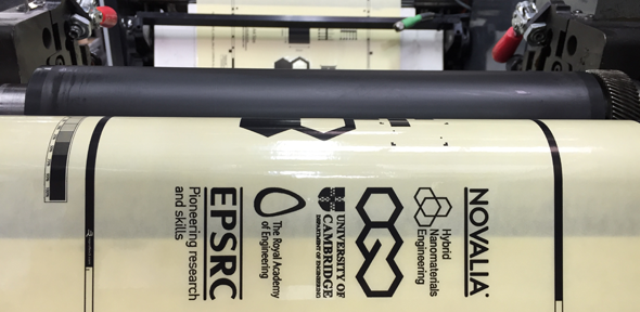A fast and cost effective method to print graphene onto substrates has been developed by a team from the University of Cambridge. They hope their new method will facilitate the manufacturing of printed electronics at an affordable price.

This research could lead the way for several commercial applications such as economical printed electronics, disposable sensors and smart packaging.
The novel method involves the printing of graphene inks using a traditional roll-to-roll printing method, similar to the way in which newspapers are printed. Graphene and other electrically conducting materials were added into traditional water-based inks and printed with the aid of standard commercial equipment. This is the first time where graphene has been used for printing on a commercial-scale at high speed.
Graphene is a 2D sheet of carbon atoms which has unprecedented electrical conductivity, flexibility, and optical transparency. This behaviour makes it ideal for printed and transparent electronics. Laboratories across the globe have produced several prototypes using graphene; however, the extensive commercial use of graphene has not yet been realised.
We are pleased to be the first to bring graphene inks close to real-world manufacturing. There are lots of companies that have produced graphene inks, but none of them has done it on a scale close to this. Being able to produce conductive inks that could effortlessly be used for printing at a commercial scale at a very high speed will open up all kinds of different applications for graphene and other similar materials.
Dr Tawfique Hasan - Cambridge Graphene Centre (CGC)
The technique developed by Hasan et al. involves suspending very small graphene particles in a ‘carrier’ solvent mixture. This is then mixed into a conductive water-based ink solution. The properties of the liquid can be controlled by modifying the ratio of the components; allowing the carrier solvent to be easily blended into a traditional conductive water-based ink.
This method will allow us to put electronic systems into entirely unexpected shapes. It’s an incredibly flexible enabling technology.
Chris Jones - Novalia
This technique can also be applied to other materials, such as metallic, semiconducting and insulating nanoparticles.
Existing conductive pattern printing makes use of a mixture of weakly conducting carbon with other materials such as silver, which is expensive. The market price for silver-based inks is about £1000 or more per kilogram. In comparison this newly formulated graphene ink costs about 25 times less. The new ink aslo has green credentials in comparison to silver which is not recyclable.
The innovative technique uses non-toxic, inexpensive and environmentally friendly solvents which can be dried rapidly at room temperature. The ‘electric ink’ formed via this method is waterproof, and sticks very well to its substrate. This ink was printed at a rate of more than 100m per minute which matches the requirements for commercial production rates for graphics printing. The printing rate was also observed to be faster than earlier known prototypes. Hasan and his colleagues worked on a transparent and flexible piano prototype using graphene-based inks two years ago. This prototype took about 6-8h to create.
With the use of the new graphene-based ink, it would be possible for highly versatile devices to be made inexpensively on papers or plastics at a rate of 300 per minute.
Novalia has manufactured an interactive poster and a printed DJ deck, which acts as a drum kit using the same technique.
In partnership with Novalia, Hasan and PhD students Guohua Hu, Richard Howe and Zongyin Yang of the Hybrid Nanomaterials Engineering group at CGC, tried out the technique on a standard commercial printing press which did not need any alterations for printing with the graphene ink. Besides creating new graphene applications, this method could also kick off completely novel business prospects for commercial graphics printers.
The UK, and the Cambridge area in particular, has always been strong in the printing sector, but mostly for graphics printing and packaging. We hope to use this strong local expertise to expand our functional ink platform. In addition to cheaper printable electronics, this technology opens up potential application areas such as smart packaging and disposable sensors, which to date have largely been inaccessible due to cost.
Dr Tawfique Hasan - Cambridge Graphene Centre (CGC)